
views
Point System

Determine if you are on a point system. Before calculating your grade, you will need to figure out if your teacher is using a point system or a weighted grade system. With a point system, everything you do in the class will be worth a certain number of points. Look for a point score on your assignments or simply ask your teacher to determine if this is how you are being graded.
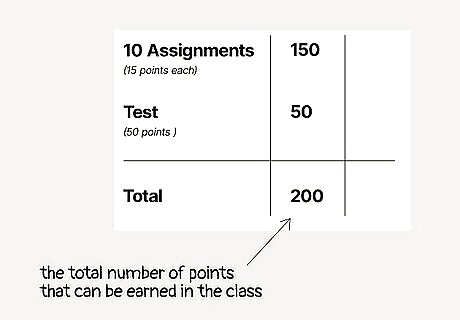
Determine the total number of earned points. Look at your syllabus, add the numbers listed on completed assignments, or ask your teacher to determine the total number of points available. If you are just trying to find out what your grade is at the moment, add together only the points for assignments you have completed so far. If you want to guess the grade you will end with in the class, you will need to ask your teacher for the total number of points that can be earned in the class.
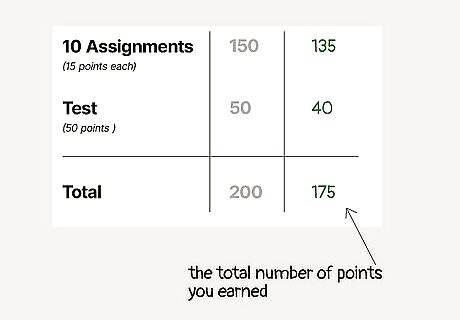
Determine the total number of points you earned. Next, add up all of the points that you earned on your assignments. You can get these numbers from the assignments themselves (if your teacher listed your point score) or you can get them by asking your teacher for your scores. If you are trying to guess what grade you will end up with, you will have to guess how well you will score on future assignments in order to calculate your final grade. You can guess these numbers by choosing a number of points similar to the percentages you have been getting or you can choose a higher number of points (to see what would happen if you study harder) or a lower number of points (to see what would happen if you studied less).
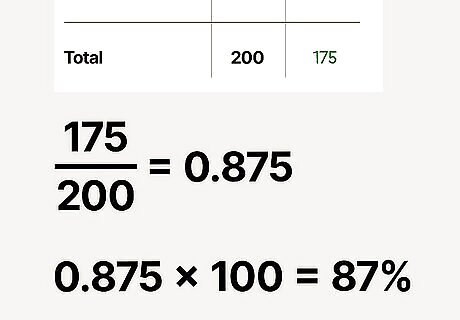
Determine your percentage. Now, take the total number of points that you earned and divide that number by the number of total earned points. You can use the points only for assignments so far or you can use the number of points for the entire class. It depends on the information available to you and your reasons for calculating your grade. An example of this equation would look like this: Sam has completed ten assignments and one test. Altogether, these assignments were worth 200 points. Sam added together their scores and found that they had earned 175 points. Sam calculates the grade (175/200=.87) to find a score of 87% for their class grade.
Weighted Grades
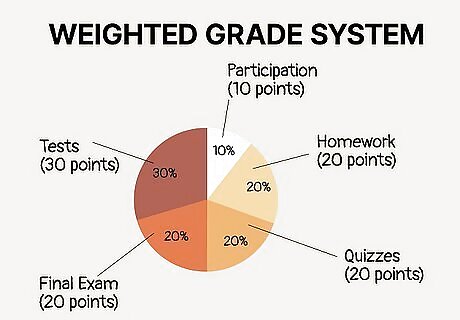
Determine if you are using weighted assignments. Your teacher may be using a weighted grading system. This means that your work will still have points, but those points will be worth different amounts based on what category it falls into. Common categories include homework, tests, quizzes, final exam, and participation. Each category will be worth a certain percentage of your grade. To get a good grade, you will need to score all or a majority of the points in each category. However, scoring fewer points in a category which is only worth a small percentage of your grade will not affect your grade as much as if the category was worth a large percentage. For ease of calculating, we will assume that each category is worth a number of point equal to its percentage weight (For example, a category worth 20% will be worth 20 points). This should make the total number of “points” for the class equal 100, which should make it significantly easier to calculate your grade. Different teachers will prioritize different things in their class, based on their philosophy of teaching and what they believe is most important. For example, some teachers will most heavily weight the final exam, whereas others will most heavily weight participation.
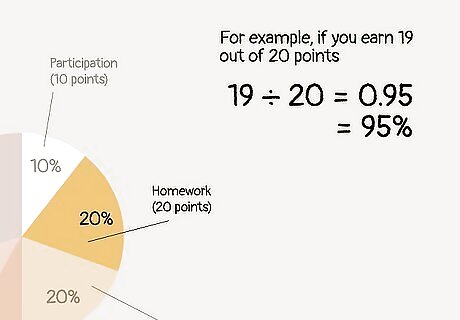
Calculate your percentage in each category. Using the same method discussed above, figure out your point percentage for each category. Think of it like figuring out your grade, but just for homework or just for your quizzes. If you are trying to figure out how you will do in the overall class, you will have to guess how well you will do on the work you have not completed.
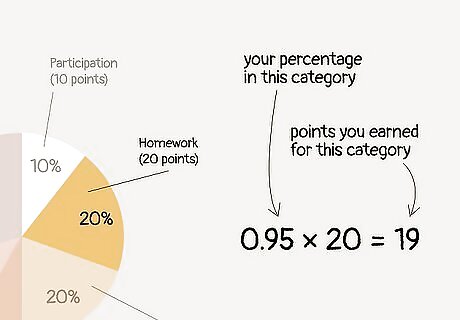
Convert those percentages to a number. Multiply that percentage score by the number for the category to find out how many points you earned for that category. For example, if you earned 95% in a category weighted at 20% (.95 x 20 = 19), you will earn 19 points for that category.
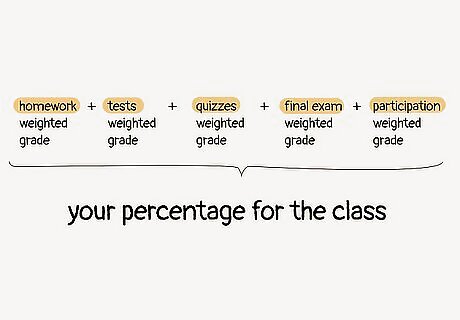
Add numbers to get your class percentage. Add the resulting numbers for each category to find out your percentage for the class. This can then be compared against the chart below to find your letter grade.
Raising Your Grade
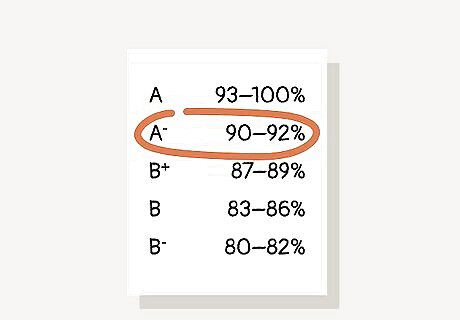
Determine the percentage and points you want. In order to figure out how much you need to raise your grade with a point system, you will first need to decide what letter grade you want in the class overall and what the corresponding percentage is (you can use the chart below). Next, use this percentage to determine how many points, out of the total number of available points in the class, are necessary to earn this percentage. Compare the number of points you’re already earned against how many points are needed to get the grade you want. Compare that number against the point count for the work you have not yet done. If the number of points available is small than the number of points needed to gain that grade, you will not be able to achieve the grade you want without some form of extra credit.

Ask your teacher for help with weighted grades. Calculating what you will need to do to raise a weighted grade is much more difficult, since there are so many different factors. The easiest method will be to ask your teacher for help and advice. You will want to focus on doing better in the categories which are more heavily weighted. This will raise your grade faster than focusing on the lesser categories. However, if those more lightly weighted categories are easy to raise (such as regular attendance to raise a participation grade), then you certainly should not ignore them.
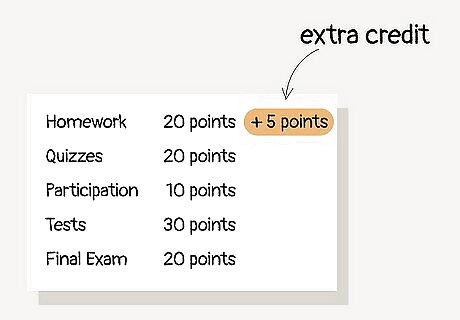
Get extra credit. Extra credit for either grading system will help raise your grade. The more the extra work is worth, the more it will do to raise your grade. However, if your teacher uses weighted grades and puts extra credit in a less weighted category, this will help less. Ask your teacher how extra credit is counted before taking on too much.
Standards vs Rank-based Grading
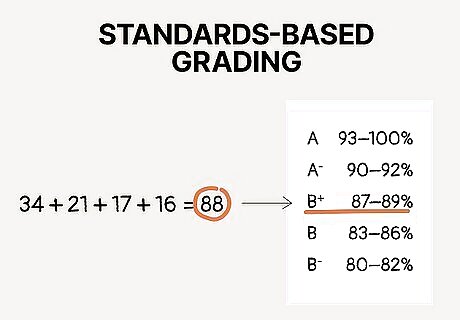
Understand standards-based grading. Your teacher may use further methods to determine your grade in the class. It is important to know which system your teacher or school uses before doing too many calculations. If your class will be graded using standards-based grading, then the methods above should accurately predict your grade. Standard-based grading is a system where all of your work can earn a set number of points and the number of points you earn directly results in your grade.
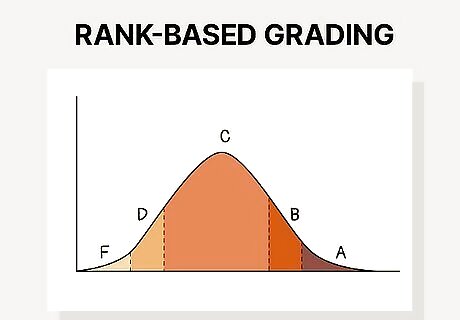
Understand rank-based grading. Rank-based grading is a more complicated system that has been adopted by some teachers and schools. In this system, all of the grades earned across all of your classmates will be placed on a curve. The majority of students will receive a middle range grade, whereas students who score higher or lower than the middle group will receive correspondingly high or low scores. Where you placed on the curve will then determine your final grade, so it can complicate your calculations. For example, you may get an “A” (even if you scored only an 85%) if your classmates all scored worse than you did. This system can be used to determine your entire grade or just particular parts. Sometimes teachers will apply it only to a final exam, for example.




















Comments
0 comment